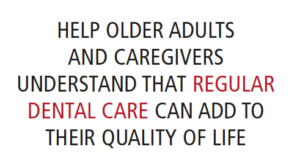
Oral Health Care for Older Adults
Innovation and action are needed to meet the needs of the growing population of older adults.
This guest editorial is the result of a conversation with my periodontist, who showed me a report on the possibility of periodontal disease contributing to mortality in older women.1 This was old news. In my years of nursing practice, I saw elderly men and women coping with the consequences of poor oral hygiene. I cited the example of a man I cared for at least 30 years ago. A physician had asked me to make a home visit to one of his patients, who had recurrent bouts of pneumonia and was failing to thrive. When I examined his oral cavity (always a part of my nursing assessment), I found his few teeth broken and full of debris. His gums were puffy, bleeding and exuding pus. With the aid of social agencies, this man was hospitalized, where he received excellent dental and medical care. He was able to return home wearing new dentures. He began to thrive and enjoy life again.
Throughout my nursing career, I tried to prevent abuse and neglect of older adults, especially the institutionalized. When I questioned caregivers about their charges with poor oral health, I often found their own self-care was lacking. When asked why their patients had not received appropriate oral hygiene, the usual answers were “it takes too much time” or “the patient refuses the care.”
My periodontist asked me for my opinions on the state of dental care for older adults from my perspective as a retired gerontological nurse and an “oldest old person.” Based on my personal and professional experience, I offer these insights in regard to the growing number of older adults who need your care and expertise.
If you listened in on a conversation with older individuals, you would hear them talk about their aches, pains and health problems. You would hear them talk about their physicians and therapists. What you would not hear was any mention of their teeth and gums — and you would not hear one word about a dentist. Why? Because dental care is an unattainable luxury for many older adults. Most do not perceive oral health as a priority in their lives. If they had received dental care in their younger lives, they retain negative memories of pain and bad smells.
THE INVISIBLE CARE TEAM MEMBER
 Beyond the costs of care and bad memories, another reason is that oral health professionals are largely the invisible or hidden members of the health professions. Rarely are dentists identified in posters and other media presentations. From what I have seen, they are also seldom visible at community activities for older adults, especially health fairs.
Beyond the costs of care and bad memories, another reason is that oral health professionals are largely the invisible or hidden members of the health professions. Rarely are dentists identified in posters and other media presentations. From what I have seen, they are also seldom visible at community activities for older adults, especially health fairs.
Here are suggestions that simply “open the door and put the light on” for oral health providers if the profession is going to evolve to meet the needs of older and oldest adults.
The best place to start is by recognizing that older adults are becoming a larger part of our society. It used to be that 85- to 100-year-olds were considered the oldest old (like me). Now there is a growing number of active centenarians and super centenarians (110 years and older). For example, one of my 100-year-old shipmates on a cruise climbed the rock wall with great agility. Oral health is just as important as the health of the rest of our bodies.
It is crucial to learn about aging in the context of body, mind and spirit. As part of professional growth and staff training, consider setting up Gerontology 101 classes and inviting guest lecturers from university gerontological, medical and nursing programs. Gerontology and special considerations for treating older adults are excellent continuing education topics.
Because cost is a significant barrier to oral health care, develop innovative policies regarding the delivery and reimbursement of services. It is imperative that more dentists become a part of Medicare, Medicaid and private insurance programs. This is no easy task, as dental insurance is very politicized (not to mention that dental care is already a stepchild of health care). Dentists will need to produce strong evidence that oral care and maintenance will save money if it can prevent the pathological consequences of poor care or lack of care. Begin by reading the insightful article by Waldman, Wong and Perlman, “Special Report — Dental Economic Realities.”2
Review how access to dental care affects this population. At present, older adults must visit the dental office for care. Transportation is a major issue for many older adults, especially if they do not drive. Finding a driver is often unreliable. Taxis are expensive, and ridesharing programs (such as Uber or Lyft) may not be accepted by this patient population. Public transportation is often inaccessible to these individuals. Once the older adult reaches the dental office, parking, walkways and heavy doors are often not user friendly. Instead of having older adults come to the dentist, strategies should be developed for oral health professionals to visit the elderly. Sponsored mobile clinics may be part of the solution, as would providing clinical care in senior housing. In fact, dentists have a great opportunity to encourage developers of senior housing to provide a health center in their buildings. There are already successful models of such centers.
EVALUATE YOUR CLINICAL SETUP
Beyond these approaches, the traditional dental office model needs to be reviewed to determine if the physical layout is elder friendly and safe. For example, can the office accommodate walkers and scooters? Is there an onsite or nearby restroom large enough and safe enough for use by older persons? Is the dental chair safe and appropriate for these patients? Can older adults safely transfer to the chair? Can an older person with disabilities be positioned safely in the chair in a way that accommodates the dental team’s needs? Can obese (especially morbidly obese) individuals fit into the chair? Dental researchers, along with architects, biomedical engineers and interior designers, need to pool their talents to address these issues.
Dental teams also should address the exceedingly complex issue of delivering care to the demented older adult. At present, many of these individuals are looked upon as “dentally futile.” Oral health care for demented patients is worthy of research. Practically speaking, a good place to start is by seeking ideas from the caregivers of these individuals.
Become visible in the community. Attend health fairs and similar events to answer questions and give out pamphlets explaining the importance of maintaining oral health. Be an advocate for the elderly by serving on health boards and committees. Seek opportunities to be part of the health segments on television, radio, the internet and social media. Mainly, be available to help older adults and caregivers understand that regular dental care can add to their quality of life.
Change in health care is inevitable. Oral health professionals need to be part of that change so people can enjoy life, no matter what their age.
REFERENCES
- Periodontal disease may increase risk of death in older women. Decisions in Dentistry. 2017;3(7):11.
- Waldman HB, Wong A, Perlman SP. Special report — Dental economic realities. Decisions in Dentistry. 2017;3(7):18,21–23.
Featured image by DEAN MITCHELL / E+ / GETTY IMAGES PLUS
From Decisions in Dentistry. December 2018;4(12):10—11.



[…] dentists and dental hygienists can talk to their patients to learn whether or not they are in a caregiving role, suggests Jennifer Titus, MPH, senior research director at NORC at the University of […]
[…] of Nursing and the University of Hawai’i at Manoa. The findings highlight barriers to care for older adults, as well as disparities in dental visits for racial and ethnic minorities and immigrant […]